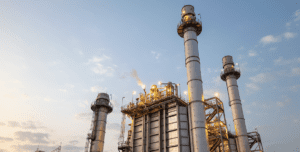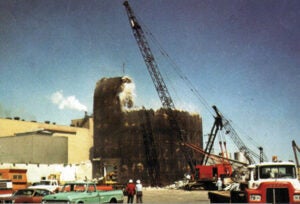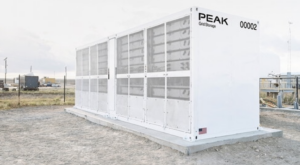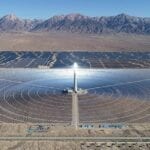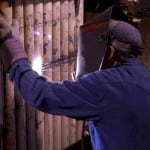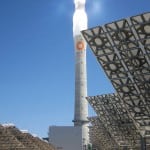Concentrated solar power (CSP) plants with thermal energy storage (TES) systems face significant material challenges. Specifically, industry-standard 347H austenitic stainless steel used in the manufacture of molten salt tanks can be subject to severe stress relaxation cracking (SRC). The results of a consortium project could have an answer for the problem. The findings suggest that transitioning to Therma 4910 could be beneficial.
Thermal Energy Storage in CSP Plants
According to the International Energy Agency (IEA), concentrated solar power has the potential to supply more than 11% of the global electricity demand by 2050, provided there is enough governmental support. But to achieve parity with fossil-fueled power generation, CSP needs dispatchability, a feature enabled through integrated TES solutions.
In CSP applications, thermal energy storage typically involves massive tanks holding thousands of tons of molten salt, which cycles between 300C and 600C. Although molten salts are theoretically capable of long-term storage with minimal heat loss (approximately one degree centigrade a day), they’re employed mainly for daily time-shifting, allowing daytime heat generation to service evening peak demands.
Stress Relaxation Cracking Challenges with 347H
CSP plants have traditionally favored grade 347H for hot molten salt tank construction due to its superior corrosion resistance and high mechanical strength at elevated temperatures, relative to other stainless steel grades. But significant issues related to intergranular stress relaxation cracking (SRC) have been observed in these tanks, particularly at temperatures of about 565C in 347H weldments operating for a relatively short period.
SRC typically arises from weld-induced residual stresses and susceptible alloy microstructures operating continuously at elevated service temperatures (above approximately 550C). In 347H, alloying element diffusion to grain boundaries and the subsequent formation of niobium carbide precipitates occurs. Accumulated strain in these regions can lead to cracking during localized stress relaxation.
Although engineers could consider post-weld heat treatment (PWHT) to ease residual stresses and mitigate stress relaxation cracking, PWHT implementation in the field can be challenging, especially in heavy wall tank constructions. If improperly executed, it might even cause SRC or other problems, diminishing its overall effectiveness. The problem is not limited to 347H; several nickel base alloys and stainless steels can be susceptible—evidenced by failure experiences with 316H in the nuclear industry’s advanced gas-cooled reactors.
Therma 4910 as a Potential Solution
In response to these concerns, industry stakeholders have expressed interest in alternative alloys and weld fillers demonstrating improved SRC resistance, along with comparable thermomechanical properties like creep and fatigue. Therma 4910 (EN 1.4910), otherwise known as 316LNB, is one such promising alloy. It’s a nitrogen- and boron-strengthened low-carbon variant of 316, demonstrating exceptional creep resistance and equally robust resistance to molten salt corrosion compared to 347H. Additional merit comes from pairing Therma 4910 with 16-8-2 filler (ER16.8.2), known to enhance SRC resistance and high-temperature thermomechanical performance compared with the matching weld fillers typically used with 347H SS welds.
But Therma 4910 is not an entirely new material. It was initially developed in the late 20th century as EN 1.4910 and employed in European coal-fired power plants during a period of temperature and pressure upgrades. Consequently, Therma 4910 provides a robust historical basis of high-temperature creep and strength performance data. This alloy is now being reintroduced to target CSP thermal storage applications.
Experimental Evaluation of Therma 4910’s SRC Resistance
To substantiate Therma 4910’s performance potential further, an industry-academic consortium was established between Outokumpu, Colorado School of Mines (Golden, Colorado), CSP industry leader Vast Energy, and construction partner CYD. The key objective was to experimentally ascertain Therma 4910’s SRC resistance relative to 347H.
As there is no standardized methodology available to evaluate SRC, the consortium used advanced thermomechanical testing procedures using the Gleeble 3500, a digital thermal and mechanical testing simulator, to conduct the tests. The simulator can exert up to 10 tons of static loads in tension or compression, and heat test specimens at extremely rapid rates (up to 10,000C/sec). The test parameters used were designed to resemble as closely as possible the metallurgical and stress state conditions experienced in heavy wall welded tanks, although it should be recognized that no laboratory SRC test methodology can fully replicate real-world conditions.
The experiments specifically assessed SRC susceptibility within the heat-affected zone (HAZ) and the weld fusion zone (FZ) using 16-8-2 filler wire. Results indicate a distinct advantage for Therma 4910. In a 22-hour Gleeble testing regimen at temperatures spanning 600C to 800C, neither the Therma 4910 HAZ (tested under initial true stresses of approximately 650 MegaPascal [MPa], or 0.174 strain) nor the fusion zone with 16-8-2 filler (tested at yield strength conditions of 460 MPa) developed any detectable cracking. Conversely, corresponding testing on the 347H HAZ and weld samples using matching filler produced cracking within hours at the elevated test temperature. Further investigations are ongoing to complete extensive test scenarios over longer durations at 600C and to investigate microstructural conditions associated with fracture development.
Preliminary Conclusions and Broader Implications
Initial findings support Therma 4910’s potential as an SRC-resistant alternative to 347H stainless steel in molten salt storage tank applications. Although its slightly higher alloying elements increase manufacturing costs relative to 347H, this can be offset by the higher elevated temperature strength of Therma 4910, and the incremental additional expenditure is minimal compared to the financial and reputational risks associated with catastrophic SRC-induced tank failures.
Overcoming material-related challenges is becoming increasingly critical as CSP’s role as a heat provider in power generation and industrial processes expands. At present, thermal energy storage serves to time-shift power generation at temperatures reaching up to 600C; however, several research initiatives are investigating operation at even higher temperatures to improve CSP efficiency and reduce operating costs. Under these demanding conditions, Therma 4910 could become an invaluable material solution with its exceptional high-temperature creep strength and superior resistance to stress relaxation cracking.
—Andy Backhouse is lead technical manager with Outokumpu. For further information, please visit: Therma 4910.



